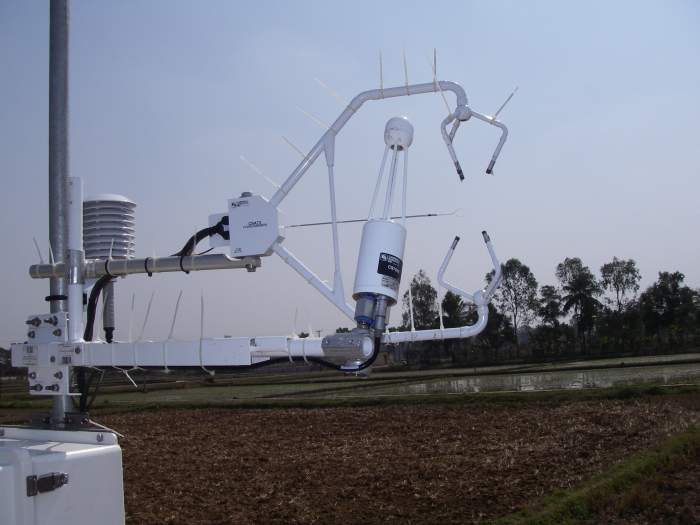




インドだけでなく世界人口の約半数にとって主食である米の栽培は、多くの人々の文化、生命、生活にとって極めて重要です。1942 年、ベンガル州の水田で壊滅的な着生褐斑病が発生しました。その結果生じた米不足と 1943 年のベンガル大飢饉を受けて、インド政府はインド農業研究評議会 (ICAR) を通じて、オリッサ州カタックに中央米研究所 (CRRI) を設立しました。CRRI は米の生産量を増やすという目標に挑戦しました。
ICAR(CRRI などを含む)とインドの農業大学の研究努力により、インドは飢餓に近い状況から脱し、世界第 2 位の米生産国となりました。しかし、この偉大なリーダーシップの役割には、インドの米生産の影響を監視するという、国だけでなく世界社会に対する大きな責任が伴いました。
人口増加により、世界の食糧需要が高まり、インドの稲作農家は、より多くの資源を消費することなく、より多くの収穫量を生み出そうと努力しています。この負担に加え、気候変動による気象パターンの変化によって、栽培環境はますます困難で予測不可能になっています。稲作の環境負荷を削減するという圧力が高まることで、これらの課題はさらに深刻化しています。CRRI は、環境を保護しながら、収穫量と効率の格差を縮め、稲作農家の収入レベルを向上させるために、どのように貢献できるでしょうか。
答えを求めて、ICAR は 2 つの気候変動プロジェクト、気候耐性農業に関する国家イニシアチブ (NICRA) と国家農業イノベーション プロジェクト (NAIP) を立ち上げました。このプロジェクトの一部は、カタックの CRRI によって実施されました。現地調査の焦点は、オープンパス渦共分散システムを使用して、温室効果ガス (GHG)、具体的には二酸化炭素 (CO 2 ) とメタン (CH 4 ) の交換を、水田 (湛水および他の生態系) の生態系炭素 (C) バランスと関連させて調査することでした。インドは食糧生産量の増加要件を満たす計画を立てていましたが、米の生産量が増えると、大気中に有害なレベルの CH 4または CO 2が放出されるのでしょうか。
CRRI は、Campbell Scientificと協力し、カタックにある同研究所の主要施設近くの低地の湛水田の真ん中に渦相関システムを構築して設置しました。連続ガス監視を行うように設計されたこのシステムは、CSAT3 3D ソニック風速計、CO 2 /H 2 O オープンパス ガス分析装置、オープンパス CH 4 分析装置、CR3000 マイクロロガー、およびさまざまなセンサー (気温と相対湿度、正味放射計、土壌温度、土壌熱流束、土壌水分) で構成されていました。コンパクトフラッシュ メモリ カードを使用して、測定データを CR3000 から手動で転送できました。
渦相関システムの設置は、2 つの理由から困難でした。モンスーン シーズンは強風が特徴で、水田は泥だらけでした。これらの課題を克服するために、システムは大きなレンガとコンクリートのプラットフォームに取り付けられ、機器が吹き飛ばされたり沈んだりしないようにしました。2 番目のシステムは、後に均質で平坦な水田の地上レベルに設置されました。
CRRI は、渦共分散データを使用して、インドの低地稲作技術が大気中の炭素の純吸収源か排出源かを判断することを意図していました。Campbell Scientificの LoggerNet と EdiRe (エディンバラ大学) を使用して処理された研究データから、CRRI は次のことを判断しました。
- 湛水田では、大気中の二酸化炭素濃度は早朝に最も高く、夕方遅くに最低となった。
- 日中、雨期と乾期を通じて、低地の水田は土壌に炭素を蓄え、純炭素シンクとして機能しました。
- 夜間には、低地の水田が炭素源として機能しました。
- CH 4 は低地の湛水稲生態系からの C 損失の原因ですが、この生態系は相当量の C を貯蔵する優れた可能性を秘めています。
CRRIは、CO2とCH4の排出を管理するのに役立つプロセスについての理解を深めるために、水田の監視を続けています 。同研究所は、インドの農業従事者に生計手段を提供し、世界に食糧を供給しながら、環境保護に引き続き取り組んでいます。